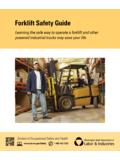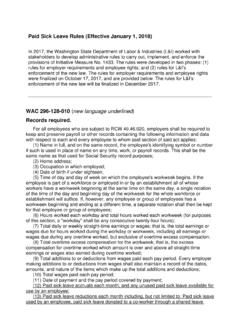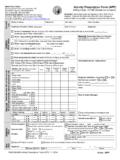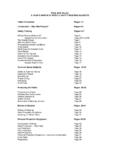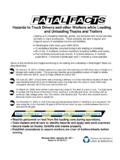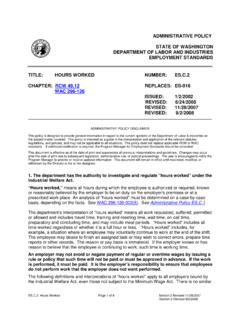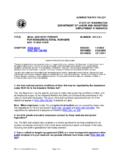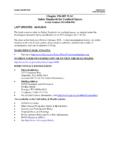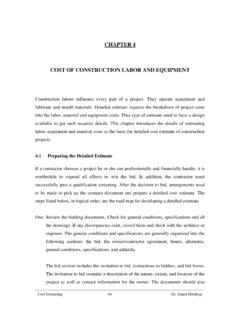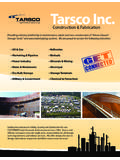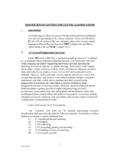Transcription of F213-008-000 Construction Industry Classification Guide
1 Construction Industry Classification GuideA photo essay Guide for the woodframe Industry in WashingtonPrepared by: Classification Development Services SectionWashington Department of Labor & Box 44148 Olympia, WA 98504-4148 Construction Industry Classification GuideA photo essay Guide for the woodframe Industry in WashingtonPUBLICATION F213-008-000 [05-2013]Table of ContentsIntroduction ..4 Classifying of the Construction Industry ..5 Record-Keeping Requirements ..6 Phases of Construction Site I. Logging ..7 II. Blasting ..7 III. Building Demolition ..7 IV. Land Foundation and Flatwork ..8 I. Locating Foundation ..8 II. Excavation ..8 III. Setting Foundation ..9 IV. Flatwork ..10 V. Foundation Waterproofing ..10 Framing the Structure ..11 Utility Construction ..13 I. To the Structure Exterior Work ..13 II.
2 Within the Structure Interior Work ..14 - Electrical Wiring ..14 - Heating/Ventilation ..15 - Plumbing ..15 Enclosing the Structure ..16 I. Roofing ..16 II. Gutter and Downspout ..17 III. Siding/Exterior Covering ..17 IV. Exterior Painting ..17 V. Garage Doors ..18 VI. Chimneys/Fireplaces ..18 Interior Finish Work ..19 I. Insulation ..19 II. Walls and Ceilings ..19 III. Interior Trim ..20 IV. Floors ..21 Finishing the Site ..22 I. Landscaping ..22 II. Fences ..23 III. Decks and Patios, Swimming Pools, External Lighting ..23 IV. Debris Removal and Preoccupancy Cleanup ..24 Miscellaneous Operations ..25 I. Temporary Barriers, Facilities, Scaffolding, and Hoists ..25 II. Draining (Dewatering) ..25 III. Permanent Yard Operations.
3 25 IV. Security Guards ..25 Appendices I. WAC 296-17-31004 Coverage requirements, and WAC 296-17-31013 Building Construction ..26 II. L&I Resources ..29 3 This manual was compiled by the Classification Development section, Insurance Services Division, Washington State Department of Labor & Industries (L&I), to assist contractors in the proper Classification of work being performed by their employees on new woodframe building Construction intent of this manual is to serve as a Guide only, and is not meant to supersede Chapters 296-17 and 296-17A of the Washington Administrative Code. Please contact your account manager to confirm Classification choices and have them added to your account. Your account manager will also give you the rate per hour at that time. If you don't have your account manager information handy, contact Employer Services at 360-902-4817.
4 4 IntroductionSingle FamilyFour-PlexApartment ComplexThis manual deals with operations associated with new woodframe building Construction . A woodframe building is defined as a building whose support structure is constructed from wood or wood products. The support structure includes floor joists, subfloors, exterior walls, interior bearing walls, and roof trusses or rafters. Woodframe buildings are constructed for either residential or commercial purposes. The end use of a building is not a contributing factor in determining the proper Classification assignment. No distinction is made between the size of a building, number of stories, or whether it is a single or multiple unit building, provided the structural support is of 100% wood or wood non-woodframe building s primary structural support would be constructed from iron, steel , concrete, masonry, or similar materials.
5 Even though the floors, wall, and ceiling may include wood or wood products as part of the building, it does not meet the definition as described above for woodframe building Construction projects which is the primary intent of this manual. This manual is formatted in a chronological order to illustrate the various phases associated with wood-frame Construction operations. The main phases are: Site Preparation Foundation and Flatwork Framing the Structure Utility Construction Enclosing the Structure Interior Finish Work Finishing the Site Miscellaneous OperationsIn addition, special sections are included in the appendices of this manual. Provided are the Special Construction Industry Rule , Safety Precautions, Risk Management Services, Toll-Free Telephone Numbers, and Statewide Service Locations (addresses and phone numbers). 5 OverviewThe general Classification policy for all businesses is to assign a basic Classification that covers an employer s entire business operation and the various occupations used by the employer within the business.
6 Examples of such exceptions which may be excluded from a businesses basic Classification (s) could involve employees who have no other duties and perform work exclusively as clerical, outside sales, pre-occcupancy cleanup, after the completion of a new building, duties in a permanent yard or shop, and security guards at a Construction site. In some cases, employers are assigned several classifications because they are involved in multiple business operations which are independent of each other and have different degrees of risks. A single Classification would discriminate unfairly against these businesses and place them at a disadvantage with competing businesses. The Classification policy within Construction industries is consistent with nonconstruction businesses. For contractors engaged in a single operation at a job site or location, such as plumbing or electrical work, a single Classification for the entire business operation applies.
7 For Construction contractors engaged in multiple operations of several phases of Construction at a job site or location, several classifications may apply to work being performed. A copy of the rule covering this policy can be found under Appendix I, Building Construction rule. As part of this rule, the department may, upon written request by a contractor prior to the start of a Construction project, authorize the use of a single basic Classification in which to report a contractor s entire Construction crew(s) as part of a specific building project. Requests for such Classification should be sent to our Employer Services section in Olympia or call your account manager for more details. Selection of the basic Classification will be determined by estimating the work hours for each Construction operation at the site or location, and calculating the premiums due for each.
8 Total estimated premiums will then be divided by the total estimated hours to produce an average rate. The basic Classification assigned to the employer that carries the rate nearest to the estimated average rate will be selected. If the estimated average rate is equally between two potential classifications, the lower of the two rates will be classifications may also be assigned, depending on which type of contractor , whether general or specialty, performs the work. These differences will be discussed under the appropriate Construction operation text. Briefly, the department defines a general contractor as a contractor who is engaged in more than one trade on a project, whereas a specialty contractor is limited to a single trade on a multiple classifications may be assigned to a Construction contractor , extra care must be taken in recording the worker hours for the various phases of the project.
9 Failure to maintain complete and accurate records can result in higher premium costs to the contractor , as the work may be assigned to the highest-rated Classification which applies to the project. Record-keeping requirements are provided in the next section (see page 6).In the Construction Industry , it is essential that accurate records be kept showing the hours of each worker in each phase of the Construction project. Without detailed time records, all of a worker's hours must be reported in the Classification with the highest level of hazard and the Construction Industry6 Record-Keeping Requirements To comply with Industrial Insurance laws, the following records should be retained for 3 years and 3 months from the start of each Construction phase your business performs as part of a project (also see Appendix I, "Coverage Requirements"): 1. Ownership records Your firm should have documents to verify the structure of your company.
10 These records include items such as: partnership agreements, articles of incorporation, bylaws and minutes of board meetings, shareholder certificates, Business Licence Application, Contractors Registration, Certificate of Industrial Insurance coverage, and IRS income tax returns. 2. Payroll records a. Original time cards or books identifying the name of the worker, each worker s social security number, date of work performed, type of work performed, and the number of hours worked by phase of Construction . b. Individual earnings records for each worker which includes name and address of worker, rate of pay, dates work performed, hours worked and totaled by quarter, gross wages earned, payroll deductions, date of payment, check number, and net amount paid. 3. Check register or cash disbursements journal This record should show name of payee, reason for payment, date of payment, amount paid, check number, bank statements, and canceled checks, if returned to you from your bank.
